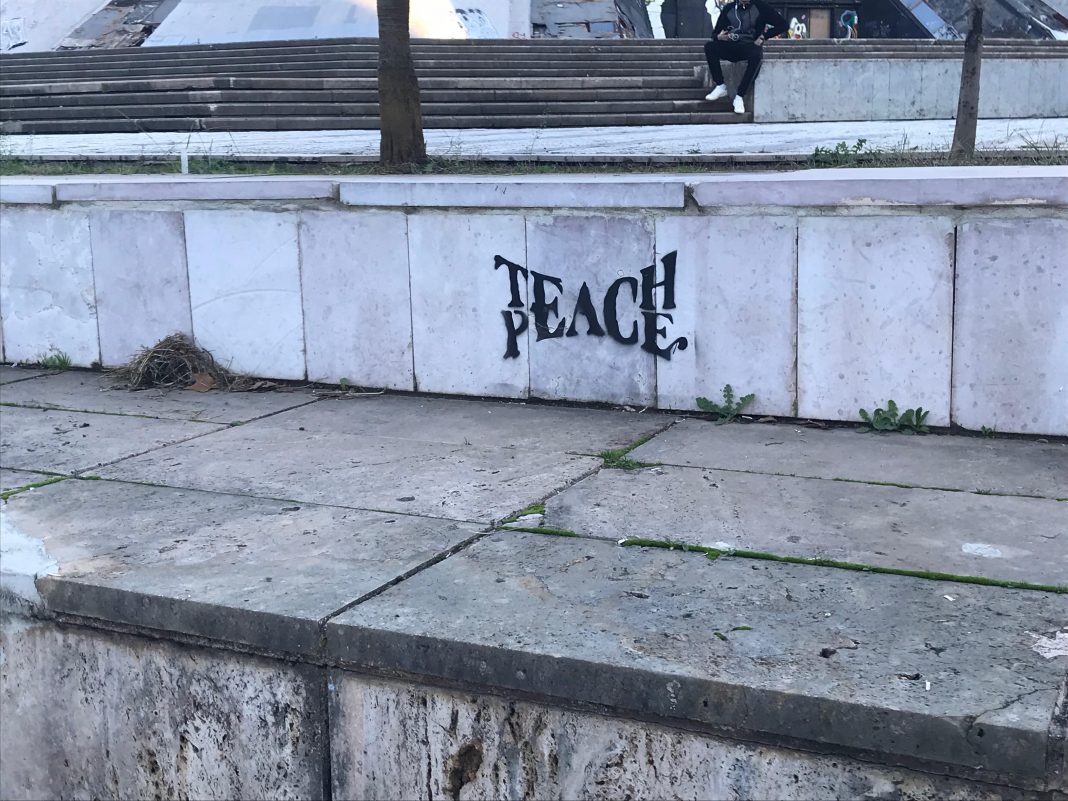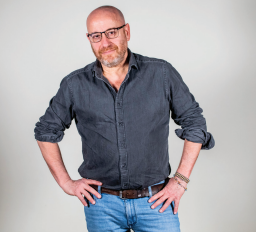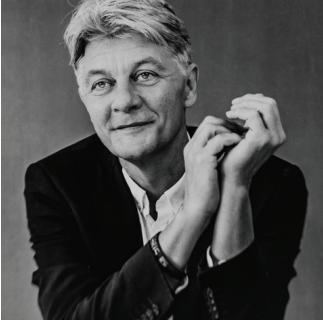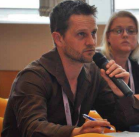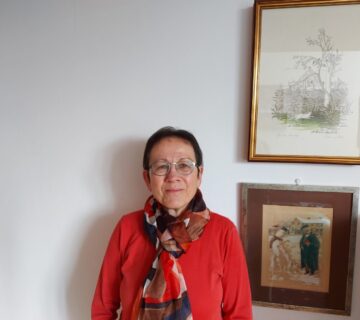Born in 1987 in Bucharest, Romania, Alice Teodorescu is a cultural analyst, blogger
and author. She studied communication and media studies at the University of
Bucharest, The Faculty of Letters, and at the University of Amsterdam, Graduate
School of Humanities. She finished her doctoral studies summa cum laude in 2017,
focusing on intercultural communication, Japanese animation and visual studies.
She published various essays, literary reviews and, even, short stories in various
online and print magazines like Dilema veche, Romania literara, Bookblog.ro,
The Eastern European Messenger, Haemus and Comunique, and scientific articles
concerning visual studies, cinematography and cultural studies in journals like Ekphrasis or various collective volumes.
By Alice Teodorescu
It was afternoon when I first set foot in Nënë Tereza airport, surrounded by hills, a white-blue sky and a cozy atmosphere. Together with a group of Eastern European journalists and visual artists, while learning to use an old film camera, we were set to explore the traces of a Communist past on the grounds, at the beach and in the minds and society of the current Albanians.
Little did I know then that it would be a journey both into a country I was just beginning to get acquainted with, and time – the time of prejudice, the time of unwritten history, the time of visual culture and more. From the eclectic Tirana to the whispers of the sea and the wind in the mountains, through forgotten places of historic injustice, Albania had many stories to tell, and I wanted to be a patient listener. And so I became, more than once, returning to the country with new questions and understandings.
It is the cultural analyst Stuart Hall that argues: culture is simply “experience lived, experience interpreted, experience defined”, so I am writing this piece with the gaze of the Other, the stranger (or should I say Stranger) whose experience lived and interpreted, now has a chance to be transformed in experience defined.
I have been many times in the shoes of the one being gazed, exposed, and labelled, so beyond the common Eastern European background, as my own national and cultural identity is filled with nuance, it is my duty to warn the reader that I shall be very conscious about the terms I use and the colours of my subjectivity.
After all, the experience, my experience needs to be interpreted and defined, as it was once lived, with all the in-betweens: present and memory, the visual and the written, East/West and so on and so forth.
The “Balkans” defined?
It was the middle of Tirana, on an April (I remember it being Spring) almost hot day, when a woman walked down to me and my partner asking for directions. She was a local, we were not, yet something in our presence probably seemed familiar. We answered in English, of course, and she smiled, leaving us to our own devices.
Yet, this sense of the familiar never left me, although it was my first contact with the country. It’s interesting how we, as humans, always look for the differences, when it’s the familiar occurrences, the known, the common ground that connects us and we should be looking for. And that reminds me, once again, as it did on that unusual warm April day, about this fuzzy idea of the Balkans atmosphere.
As a scholar and proponent of cultural studies, there are all these terms that come to mind and that we get tangled in, in an attempt to create order into discourse and life, not as we know it, but as we represent it: from Said’s Orientalism, to Todorova’s Balkanism and Anderson’s imagined communities straight to the contemporary global imaginary of Steger. Let’s take a short dive into them, to make the experience lived go beyond concepts and labels.
Vesna Goldsworthy in Balkan as Metaphor points out that “as is often the case, the Balkans are thus defined not by identity traits of their own but by their position on the fault line, their fate predetermined by their explosive “in-betweenness.” (25) It is a cultural critique that follows in the footsteps of Edward Said’s notion of Orientalism (as opposed to the West and Occidental “gaze”), which he defines as “a distribution of geopolitical awareness into aesthetic, scholarly, economic, sociological, historical, and philological texts.” (12) Whether the same or with different nuances, as the academic debates are long and passionate, it is this undefined Other that needs a definition, which seems to escape the scholars’ grasps. Then again, it is Maria Todorova who underlines: “While historians are well aware that dramatic changes have occurred on the peninsula, their discourse on the Balkans as a geographic/cultural entity is overwhelmed by a discourse utilizing the construct as a powerful symbol conveniently located outside historical time. And this usage itself is the product of nearly two centuries of evolution. There has appeared today a whole genre dealing with the problem and representation of otherness.”(7), discussing this ambiguous Other, referenced as a cultural entity born only in the eighteenth century, transforming the North / South divide, into an East / West divide. It is more a need of categorizing and naming names that all these scholars identify, still names having unusual power sometimes.
Apart from the historic and geopolitical aspects, which are more or less evident in the eye of the contemporary, the Balkans remain an ambiguous Other only until you get to know them, until you start looking at the commonalities.
I am of Balkans, just as Tirana and Durrës, Shkodër and Gjirokastër, and all the other beautiful places I have seen. For me, beyond my “cultural studies”, it is a common identity that translates into a certain geography, a politeness that is close to my heart, a way of showing appreciation to your guest, amazing food and a sense of belonging, beyond space of time. And so the familiar is back. Especially, when you talk linguistics to your Albanian translator and you identify all these common Romanian-Albanian words for simple, delicious things in life like sour cherries (vișină / vishnje).
The cult & the pop experience
The imagined community of the 19th and 20th centuries has transformed, as Manfred B. Steger explains, into a global imaginary, the people’s growing consciousness of belonging to a global community, where local traditions intertwine and get confused with global trends. I see that everywhere I go, in the commercials on the streets, the feel of urban cultures, the fashions, the movies, the books or magazines.
I am of the global, as well, born in transition (from Communism to democracy) and having the chance to travel and learn new localities and new traditions, so our next stop in the quest of my lived experience is the visual. I remember vividly the sense of wonder and delight, entering the Marubi National Museum of Photography in Shkodër.
The story of Pietro Marubi, an Italian painter and photographer, running for political reasons to Albania, creating the first photographic studio (and a prolific one, passing through 3 generations at that) and transforming the face of the city is a great metaphor for converting and melting into the familiar. What better way to understand a new culture than to observe it and capture it, with all its nuances and flavours? Looking at his and his heirs’ images depicting tribal leaders, traditional garments, but also the town life, while using my smartphone to recapture what was once lived, made me think about this sense of belonging once again. It is the digital and the visual that make me and my generation belong to the global, yet I could see the familiar and the unknown in the shapes of the clothing and the lines of the portraits, reminding me of old history lessons and the late medieval times of the 3 Romanian territories. Both familiar and unknown, all the same.
It was a feeling I encountered again and again walking in the center of Tirana, looking at the famous pyramid and its surrounding graffities, finding street art at every corner, in every possible shape. Teach/Peace one says, making me think of Musine Kokalari and her intellectual resistance, fighting a cruel totalitarian regime. Why do you wear that stupid mansuit? another one questions, referencing the cult movie Donnie Darko, while yet another one shows the Snapchat ghost in its yellow shape, floating around the city.
The cult and the pop collide and combine in visual forms, becoming its own way of resisting any definition. It is not surprising that in 2018, visual artists from Albania and beyond, chose to create 13 murals in a street art festival, depicting such things as Albanian traditional carpets, Mother Teresa in urban clothing or cultural and ethnic symbols pointing to the unique blend of faiths in the region. The resistance to be simply labelled continues, as the visual transgresses borders and further shapes the global imaginary.
It is the common ground, taking back the mediascape, as Arjun Appadurai once defined it, showing the images of the world through cinema, television, prints, advertising etc. in global cultural flows that have the power to create a common meaning. Or that is how I choose to see it.
The memory of a place – the individual and the collective
It is allowed to express your need for community. It is allowed to discuss about what concerns you. It is allowed to build a map. It is allowed to discover yourself through where you live. are but a few of the 18 points of a manifesto standing in the art center where my journey through Albania first started. A strong counterpoint to the silent reminders of the horrors of Communism that I have documented through political prisons and vestiges of forced labour camps (the “real” purpose of my travels). Yet, as I re-read the words of this piece of contemporary performative art, I am reminded of my lived experience, which once again stirs the familiar inside.
It is this art squat center, with its manifestos and free hugs, books and pick-ups, and the Communist kitsch café in Tirana, with its jam jars and macramé on the walls, not to mention the famous glass fish, that finally “transport” me home – to my grandmother’s dining room, looking at the front row of the cabinet while everyone else is eating, to the taste of coffee sipped with friends, to the chatters of the new urban youngsters, turning Communist paraphernalia into an aesthetics of the ironic and the consumerist, to a sense of understanding, once more, that we have a lot more in common than we first think.
It is allowed to explore the space. It is allowed to think.
I have been building my own map, of a shared identity and a shared passion for the visual and its meanings, a map that grows even now, with every word I write, recollecting this journey and giving it a new life. The visual geographies, the tastes, the conversations, the places of splendor (the sea, the mountains of Vlora, the greenery everywhere) and of pain (Porto Palermo, the camps), all have transformed the lived experience into a new definition of the common background.
Instead of a conclusion
I still wear the Bunk’art clip on the front of my rucksack (remember, the new aesthetics of the ironic and the cultural pop), while recollecting all that I was fortunate to explore. Albania has unraveled in front of my eyes and mind, leaving behind new questions.
It is allowed to be curious. It is allowed to ask questions.
There are, yet, many things to better understand: Why was Communism so harsh in a country so small?, Why is there such a strong sense of visual art here? How does the multicultural blend with the cultural flows of globalization? Why is print advertising so good? How is the new urban culture evolving?, and a lot of new points to address. All these questions and even more are still running wild in my head, begging the need for another journey to extend my map.
Notes
Goldsworth, Vesna, “Invention and In(ter)vention: The Rhetoric of Balkanization” in Bjelic, Dusan et al.(eds.), Balkan as metaphor. Between Globalization and Fragmentation, Cambridge, Massachusetss, London, England: MIT Press, 2002, pp.25-38.
Said, Edward, Orientalism. Western Conceptions of the Orient, New York: Penguin Books, 1995.
Steger, Manfred B., Globalization. A very short introduction, Oxford: Oxford University Press, 2003.
Todorova, Maria, Imagining the Balkans, New York, Oxford: Oxford University Press, 1997.

